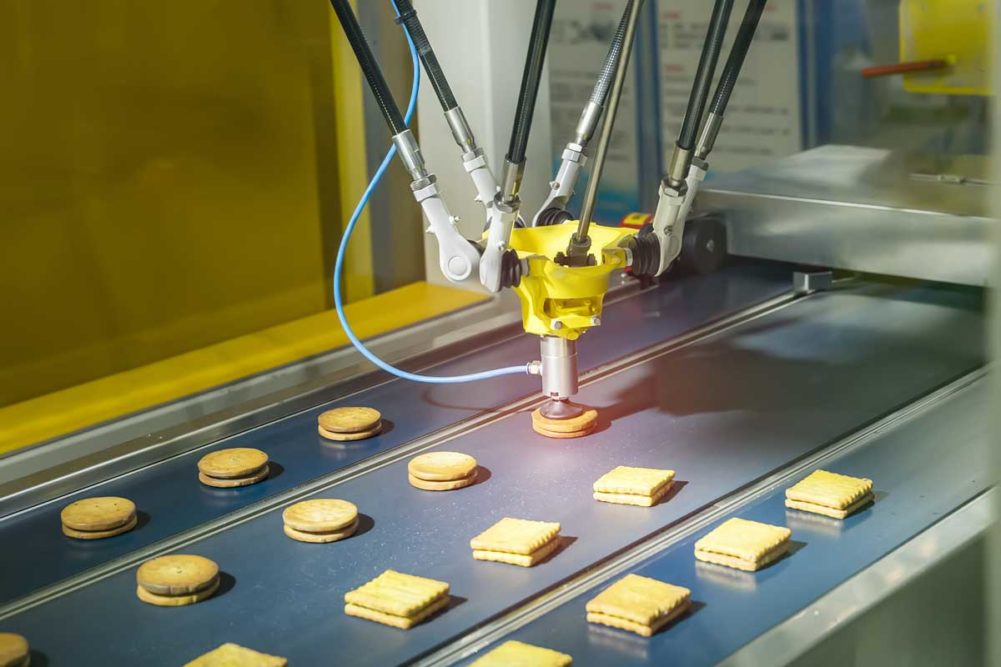Advances in sensor technology, data analytics and robotic components are driving robots that are more intelligent and flexible than ever before, enabling the wider adoption and expansion of robotics into new applications and industries, according to the Robotics: Innovation 2 Implementation report. Markets, like the baking and snack sector, are now looking to robotics and automation as a way to combat challenges ranging from the proliferation of SKUs (stock-keeping units) to the continuous lack of skilled workers, according to the report, produced by PMMI, The Association for Packaging and Processing Technologies.
The report also reveals that OEMs view baking and snack as one of the most substantial opportunities for robot manufacturers as advancements in vision sensors can offer gentler and smaller product handling. Robots also provide greater precision as end-of-arm tooling continues to develop.
The perception within the baking and snack market, however, is that robotic technology is still too expensive, according to PMMI’s Snack Foods – Packaging and Processing Market Assessment and Trends report. This leads a large portion of baking and snack CPGs to say that a robotics investment is something they foresee at their plants in the next five to 10 years, versus the next two to three years. OEMs will need to partner with and educate CPGs regarding the increase of affordable, robotically equipped machines.
Why robots and why now?
Robotic handling of baking and snack items was traditionally challenging due to the wide range of products and variations in size, shape and fragility. As Robotics: Innovation 2 Implementation explains, improvements in gripper technology have helped overcome some of these concerns, now utilizing robots with improved sensing and sensitivity to pressure in the handling of baked foods and snacks. Robotics can improve pick-and-place filling capability and reduce the need for hand packing items like bars and tray-based non-perishable snacks (e.g., cookies). For secondary packaging, robotics can provide higher precision case loading for shelf-ready or retail-ready packaging applications.
The increased use of machine vision solutions enables robots to handle and sort different products by differentiating them according to any number of variables like size, shape or type. For example, robots are being used in quality control by picking out the overcooked product during processing and before packaging. The integration of vision systems, along with rapid developments in artificial intelligence and deep learning, is creating opportunities to better automate this quality control process. Cameras can monitor attributes and use this information to identify deviation from acceptable parameters. A snack cake that has broken apart, for example, can be identified and removed from the production line.
While automation and safety equipment has helped significantly in reducing workplace injuries, using robots can further reduce risks to workers.
The trend of SKU proliferation creates shorter production cycles, and manufacturers predict that robotics will continue to grow along baking and snack packaging lines. Widespread use of 3D and color cameras will target a range of applications, including de-palletizing, bin picking, pick and place, assembly, packaging and quality control, to achieve consistent product output and optimal efficiency. Despite the increase in ability, robots have become more cost-effective than in the past, particularly for programmable pick and place robots.
Even collaborative robots (cobots) can lower the cost of a workstation on lines with shorter runs or unusual package configurations. A cobot can work safely alongside humans without a working cell or industrial fencing. It is equipped with additional sensing, allowing it to quickly identify contact with foreign objects within its working envelope and stop moving immediately. This enables it to operate directly with humans without fear of causing injury. Unlike traditional robots, cobots operate in cageless environments. It minimizes a cobots footprint while also reducing initial upfront costs.
There are many key benefits that make cobots particularly suitable in helping the food and beverage industry increase automation levels. While traditional robots require someone with programming expertise to help set up the robot, cobots can be simply programmed by having an operator move the robot to desired fixed points, which are memorized by the robot and then can be automatically repeated. Many cobots are almost set up out of the box. In addition, as they do not need additional safety equipment or fencing, they can be quickly introduced to the manufacturing line.





